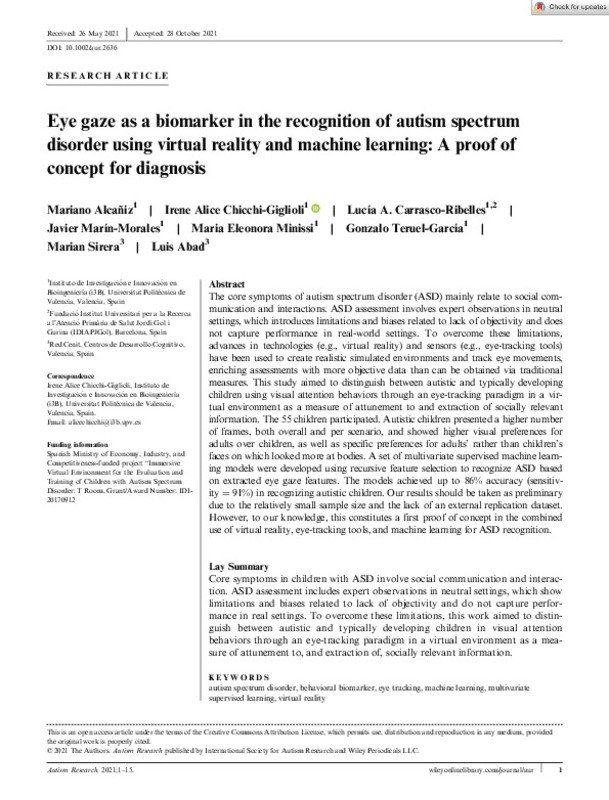JavaScript is disabled for your browser. Some features of this site may not work without it.
Buscar en RiuNet
Listar
Mi cuenta
Estadísticas
Ayuda RiuNet
Admin. UPV
Eye gaze as a biomarker in the recognition of autism spectrum disorder using virtual reality and machine learning: A proof of concept for diagnosis
Mostrar el registro sencillo del ítem
Ficheros en el ítem
| dc.contributor.author | Alcañiz Raya, Mariano Luis
|
es_ES |
| dc.contributor.author | CHICCHI-GIGLIOLI, IRENE ALICE
|
es_ES |
| dc.contributor.author | Carrasco-Ribelles, Lucia A.
|
es_ES |
| dc.contributor.author | Marín-Morales, Javier
|
es_ES |
| dc.contributor.author | Minissi, Maria Eleonora
|
es_ES |
| dc.contributor.author | Teruel-Garcia, Gonzalo
|
es_ES |
| dc.contributor.author | Sirera, Marian
|
es_ES |
| dc.contributor.author | Abad, Luis
|
es_ES |
| dc.date.accessioned | 2022-02-04T19:03:36Z | |
| dc.date.available | 2022-02-04T19:03:36Z | |
| dc.date.issued | 2022-01 | es_ES |
| dc.identifier.issn | 1939-3792 | es_ES |
| dc.identifier.uri | http://hdl.handle.net/10251/180499 | |
| dc.description.abstract | [EN] The core symptoms of autism spectrum disorder (ASD) mainly relate to social communication and interactions. ASD assessment involves expert observations in neutral settings, which introduces limitations and biases related to lack of objectivity and does not capture performance in real-world settings. To overcome these limitations,advances in technologies (e.g., virtual reality) and sensors (e.g., eye-tracking tools) have been used to create realistic simulated environments and track eye movements, enriching assessments with more objective data than can be obtained via traditional measures. This study aimed to distinguish between autistic and typically developing children using visual attention behaviors through an eye-tracking paradigm in a virtual environment as a measure of attunement to and extraction of socially relevant information. The 55 children participated. Autistic children presented a higher number of frames, both overall and per scenario, and showed higher visual preferences for adults over children, as well as specific preferences for adults¿ rather than children¿s faces on which looked more at bodies. A set of multivariate supervised machine learning models were developed using recursive feature selection to recognize ASD based on extracted eye gaze features. The models achieved up to 86% accuracy (sensitivity = 91%) in recognizing autistic children. Our results should be taken as preliminary due to the relatively small sample size and the lack of an external replication dataset. However, to our knowledge, this constitutes a first proof of concept in the combined use of virtual reality, eye-tracking tools, and machine learning for ASD recognition. | es_ES |
| dc.description.sponsorship | Spanish Ministry of Economy, Industry, and Competitiveness-funded project "Immersive Virtual Environment for the Evaluation and Training of Children with Autism Spectrum Disorder: T Room, Grant/Award Number: IDI20170912 | es_ES |
| dc.language | Inglés | es_ES |
| dc.publisher | John Wiley & Sons | es_ES |
| dc.relation.ispartof | Autism Research | es_ES |
| dc.rights | Reconocimiento (by) | es_ES |
| dc.subject | Autism spectrum disorder | es_ES |
| dc.subject | Behavioral biomarker | es_ES |
| dc.subject | Eye tracking | es_ES |
| dc.subject | Machine learning | es_ES |
| dc.subject | Multivariate supervised learning | es_ES |
| dc.subject | Virtual reality | es_ES |
| dc.subject.classification | ESTADISTICA E INVESTIGACION OPERATIVA | es_ES |
| dc.subject.classification | EXPRESION GRAFICA EN LA INGENIERIA | es_ES |
| dc.title | Eye gaze as a biomarker in the recognition of autism spectrum disorder using virtual reality and machine learning: A proof of concept for diagnosis | es_ES |
| dc.type | Artículo | es_ES |
| dc.identifier.doi | 10.1002/aur.2636 | es_ES |
| dc.relation.projectID | info:eu-repo/grantAgreement/MINECO//IDI-20170912//Entorno virtual inmersivo para la evaluación y capacitación de niños con trastorno del espectro autista: T Room/ | es_ES |
| dc.rights.accessRights | Abierto | es_ES |
| dc.contributor.affiliation | Universitat Politècnica de València. Departamento de Ingeniería Gráfica - Departament d'Enginyeria Gràfica | es_ES |
| dc.contributor.affiliation | Universitat Politècnica de València. Instituto Interuniversitario de Investigación en Bioingeniería y Tecnología Orientada al Ser Humano - Institut Interuniversitari d'Investigació en Bioenginyeria i Tecnologia Orientada a l'Ésser Humà | es_ES |
| dc.description.bibliographicCitation | Alcañiz Raya, ML.; Chicchi-Giglioli, IA.; Carrasco-Ribelles, LA.; Marín-Morales, J.; Minissi, ME.; Teruel-Garcia, G.; Sirera, M.... (2022). Eye gaze as a biomarker in the recognition of autism spectrum disorder using virtual reality and machine learning: A proof of concept for diagnosis. Autism Research. 15(1):131-145. https://doi.org/10.1002/aur.2636 | es_ES |
| dc.description.accrualMethod | S | es_ES |
| dc.relation.publisherversion | https://doi.org/10.1002/aur.2636 | es_ES |
| dc.description.upvformatpinicio | 131 | es_ES |
| dc.description.upvformatpfin | 145 | es_ES |
| dc.type.version | info:eu-repo/semantics/publishedVersion | es_ES |
| dc.description.volume | 15 | es_ES |
| dc.description.issue | 1 | es_ES |
| dc.identifier.pmid | 34811930 | es_ES |
| dc.relation.pasarela | S\451334 | es_ES |
| dc.contributor.funder | Ministerio de Economía, Industria y Competitividad | es_ES |








